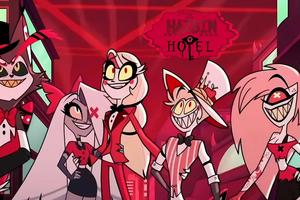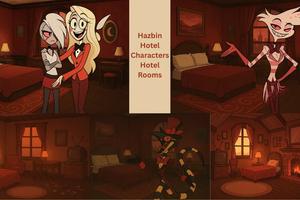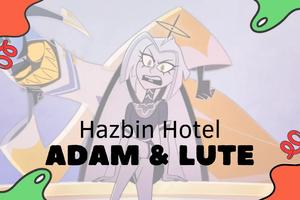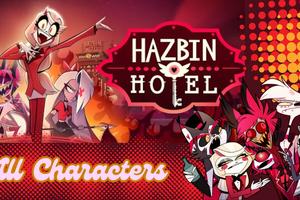How Did All the Hazbin Hotel Characters Die - Explore The Dark Backstories

Key Takeaways
Essential insights to remember
Most Hazbin Hotel characters were humans who died and were sent to Hell, with deaths spanning from the 1880s to 2014.
Alastor died in 1933 due to dogs and a gunshot to the head, while Angel Dust died from a drug overdose in 1947.
Some characters' deaths remain unconfirmed, with multiple fan theories exploring possibilities.
Characters' deaths often influence their demonic forms and personalities in Hell.
Creator Vivienne Medrano (Vivziepop) has confirmed some death stories while leaving others open to interpretation.
Introduction
Welcome to the macabre world of Hazbin Hotel, where demons roam and sinners seek redemption! 🔥 This adult animated series, created by Vivienne "Vivziepop" Medrano, has captivated audiences with its distinctive art style, dark humor, and compelling characters. At the heart of the show's premise lies a fascinating concept: almost everyone in Hell was once a living, breathing human who met their demise in various tragic circumstances.
The manner in which these characters perished not only serves as crucial backstory but often influences their demonic appearances and psychological profiles in the afterlife. From gruesome murders to accidental deaths, each character carries the weight of their mortal end into their eternal damnation.
As we delve into the fateful endings of these beloved characters, we'll explore how their deaths connect to their current existence and demonic forms. Whether you're a devoted fan or a newcomer to the Hotel, understanding these dark origins adds significant depth to the vibrant, chaotic world of Hell's rehabilitation project.

Main Character Deaths
Alastor: The Radio Demon's Violent End
Alastor, the infamous Radio Demon, met his demise in 1933 at the age of 30 in New Orleans. 📻 His death is one of the most documented among the cast, though specific details remain somewhat nebulous. What we know with certainty is that his end involved both dogs and a fatal gunshot wound to the head.
Before his death, Alastor led a double life as both a charismatic radio host by day and a sadistic serial killer by night. This duality manifested in his demonic form, which retains elements of both his professional persona and the deer-like appearance that may reflect his final moments as prey rather than predator.
Several theories about his exact death circumstances persist:
- Police Pursuit Theory: Authorities finally identified him as the serial killer, setting K-9 units on his trail before officers delivered the fatal shot
- Hunter's Mishap Theory: While disposing of a victim in the Louisiana bayou, he was discovered by hunting dogs and subsequently shot by their owner
- Vigilante Justice Theory: Local citizens uncovered his crimes and enacted frontier justice with bloodhounds and firearms
The humiliating nature of his death—being hunted like an animal after years as a feared predator—explains why Alastor reportedly dislikes discussing it. His demonic transformation into a deer-like entity serves as poetic justice, eternally marking him with the symbolism of prey.
His death marked the end of a terrifying chapter in New Orleans history but birthed one of Hell's most formidable overlords.
Angel Dust: The Tragic Overdose
Angel Dust, born Anthony to the Italian-American Ragno crime family, met his end in 1947 New York through a fatal drug overdose. 💉 His death represents the tragic culmination of a life caught between familial expectations and personal desires, ultimately consumed by substance abuse that would ironically become his hellish namesake.
The specific circumstances surrounding his overdose have been subject to various interpretations, though creator Vivienne Medrano has confirmed that phencyclidine (PCP) — nicknamed "angel dust" — was the substance that claimed his life, creating a morbid connection to his demonic moniker.
His death narrative encompasses several poignant elements:
- His struggle with acceptance in a traditional mafia family
- The post-WWII era's underground gay culture
- The beginning of organized crime's involvement in drug trafficking
- The dangerous escape mechanisms employed by marginalized individuals
Records indicate that Anthony was approximately 35 years old when he perished, having spent his final years caught between his obligations to the family business and his authentic self. The prevailing theory suggests he was discovered unconscious and brought home, where his family—mistaking his condition for mere intoxication—failed to seek proper medical intervention, leading to cardiac arrest.
His transformation into a spider-demon upon arrival in Hell connects symbolically to both his family name (Ragno meaning "spider" in Italian) and the tangled web of dependencies and relationships that characterized his mortal existence. The six arms of his demonic form may represent the multiple facets of his identity that he juggled in life.
Angel's death story serves as a cautionary tale about the lethal consequences of escapism and the profound isolation experienced by those living authentically in unaccepting times.
Vaggie: Theories Behind Her Demise
Vaggie, Hell's perpetually frustrated voice of reason, has one of the most enigmatic death stories among the main cast. 🖤 What we know with certainty is minimal: she died in 2014, making her one of the most recently deceased inhabitants of the Hazbin universe. Her predominantly human appearance—unusual for sinners in Hell—has been confirmed by Vivienne Medrano to reflect that she suffered from "more human problems" during her mortal existence.
The theories surrounding Vaggie's death are as complex as her character:
- Hate Crime Hypothesis: Many fans believe Vaggie (likely named Vagatha in life) may have been a victim of violence motivated by prejudice against her sexual orientation or ethnicity as a Salvadoran woman
- Asphyxiation Theory: Some evidence points to death by suffocation or strangulation, potentially explaining her occasionally raspy voice
- Suicide Speculation: Her intense anxiety and defensive personality have led some to theorize she took her own life, possibly explaining her pronounced empathy toward other suffering souls
The X-shaped mark over her left eye remains particularly intriguing. While some interpret it as a death wound, others believe it occurred post-mortem during an encounter with angelic weapons in Hell. This theory gains credence when considering her extensive knowledge about exterminators and celestial armaments.
Her death's recency may explain her exceptional adaptation to Hell compared to characters like Alastor, who maintains anachronistic speech patterns and references. Unlike many denizens who have had decades or centuries to acclimate, Vaggie's wounds—both literal and metaphorical—remain relatively fresh.
The ambiguity surrounding her death mirrors her complex role within the series—always partially obscured, fiercely protective, and harboring depths that even those closest to her may not fully comprehend.
Charlie: The Princess of Hell (Special Case)
Charlie Magne stands apart from the rest of the Hazbin Hotel cast in a fundamental way—she never experienced death at all. 👑 As the daughter of Lucifer and Lilith, Charlie is Hell-born royalty, making her the only protagonist who has never lived a human life on Earth. This unique origin fundamentally shapes her optimistic perspective on redemption and rehabilitation.
Born into immense privilege and power, Charlie possesses abilities far beyond those of fallen human souls. Her demonic manifestations—including her occasional transformation into a more monstrous form—come naturally rather than as twisted reflections of earthly sins. However, this innate power creates a paradoxical naivety; having never experienced humanity, mortality, or the journey to damnation, Charlie's understanding of redemption remains largely theoretical.
Her eternal existence presents several unique characteristics:
- Limited Comprehension of Death: Having never experienced mortality, Charlie cannot truly understand the traumatic transitions her patrons have endured
- Unfamiliarity with Human Nature: Her idealism stems partly from never having lived among humans and experienced their capacity for both good and evil firsthand
- Purer Motivation: Unlike other characters with complex agendas, Charlie's desire to rehabilitate sinners comes from genuine empathy rather than personal gain
- Immortal Perspective: Her existence spans centuries, giving her a unique temporal viewpoint on Hell's social evolution
This fundamental difference between Charlie and the sinners she hopes to redeem creates much of the narrative tension within the series. The princess who has never died attempting to understand and heal those defined by their deaths represents one of the show's central ironies.
Despite—or perhaps because of—her lack of a death story, Charlie embodies the show's central question: can the fundamental nature of a soul change, or are we forever defined by our origins and endings?
Supporting Character Deaths
Husk: The Gambler's Final Hand
Husk, the cantankerous, alcohol-soaked feline demon, embodies the archetype of a man who lived fast and died hard. 🎲 His death, occurring sometime in the 1970s, remains officially unconfirmed, yet contextual evidence provides compelling clues about his mortal end.
A Vietnam War veteran turned gambling addict, Husk's human life appears to have spiraled into a destructive cycle of alcoholism and risk-taking. His demonic form—a winged cat with card suit symbols embedded in his fur—reflects both his gambling obsession and the feline's proverbial nine lives that he ultimately exhausted.
Several prevailing theories exist regarding his specific cause of death:
- Liver Failure: The most widely accepted theory suggests his body finally surrendered to years of alcohol abuse, a slow and painful death consistent with his bitter outlook
- Gambling Dispute: Some speculate he was killed over unpaid debts or accusations of cheating, explaining his cynical view of both winners and losers
- Suicide: His nihilistic perspective and self-destructive tendencies have led some fans to theorize he may have taken his own life during a moment of despair
- Fatal Fall: Another theory proposes he fell from a significant height while intoxicated, possibly explaining his transformation into a winged creature in death
His Las Vegas connections and casino expertise suggest whatever ended his life occurred within the gambling world that consumed his post-war existence. The timeline of his death places him in the era when Vegas transformed from mob-controlled venues to corporate entertainment empires.
Husk's character exemplifies the "dead man walking" phenomenon—someone who emotionally perished long before physical death claimed him. His afterlife existence seems barely distinguishable from his final living years, suggesting his cynical perspective that "it's all the same shit, different circle."
The irony of Husk's immortality in Hell contrasts sharply with his apparent disregard for his mortal life—an eternity to contemplate the fleeting pleasures that ultimately destroyed him.
Niffty: 1950s Mystery
Niffty, the diminutive, one-eyed cleaning enthusiast, perished sometime during the 1950s under circumstances that remain tantalizingly obscure. 🧹 Her peppy demeanor and seemingly innocent personality create a stark juxtaposition with her presence in Hell, suggesting her sins might be less obvious than those of her companions.
Her 1950s death places her squarely in post-war America, an era characterized by rigid social conformity, traditional gender roles, and the birth of suburban domesticity. This context provides crucial insight into her obsessive-compulsive cleaning habits and fixation on finding a husband—behaviors that mirror the idealized housewife archetype of that period.
Fan theories about her death encompass numerous possibilities:
- Household Chemical Exposure: Her cleaning obsession may have begun—or ended—with fatal exposure to toxic cleaning products common in the pre-regulation era
- Domestic Violence: Her desperate search for male companionship might indicate trauma from an abusive relationship that ended fatally
- House Fire: Her speed and agility in Hell could represent a desperate attempt to escape flames that ultimately claimed her
- Mental Health Crisis: The 1950s saw primitive and often harmful approaches to treating conditions like OCD, potentially leading to fatal "treatments"
- Murder Victim: Some darker theories suggest her cheerful facade masks trauma from a violent death, potentially at the hands of someone who rejected her romantic advances
Her small stature and cyclopean appearance might contain clues to her demise, though creator Vivienne Medrano has kept Niffty's backstory intentionally vague compared to characters like Alastor and Angel Dust.
The 1950s setting of her death also coincides with the height of pulp fiction and horror comics, potentially explaining her seemingly contradictory blend of wholesomeness and disturbing comfort with violence. The era's superficial properness often masked darker undercurrents—much like Niffty herself.
Whatever claimed her life, Niffty's eternally youthful appearance suggests she died relatively young, adding another layer of tragedy to her perpetually cheery persona.
Sir Pentious: Victorian Villain's End
Sir Pentious, the megalomaniacal snake demon with steampunk sensibilities, met his mortal end in 1888 during the height of the Victorian era. 🎩 This precise dating places his death squarely in a period of remarkable technological innovation, imperial expansion, and social stratification—all elements reflected in his villainous persona and contraptions.
As an inventor and self-proclaimed genius, Sir Pentious embodies the Victorian archetype of the mad scientist pushing boundaries without ethical consideration. His transformation into a serpentine creature symbolically connects to the Biblical tempter, suggesting his technological pursuits may have crossed moral lines or caused significant harm.
While official sources remain vague about his specific cause of death, several historical contexts provide compelling theories:
- Laboratory Catastrophe: His obsession with dangerous inventions likely culminated in an experimental disaster, perhaps involving steam power or primitive electrical work
- Tuberculosis: The prevalent "white plague" claimed countless Victorian lives, including many upper-class intellectuals of the era
- Assassination: His pompous attitude and potentially dangerous innovations might have made him the target of rivals or concerned authorities
- Poisoning: His serpent form could symbolize a death by toxins, possibly self-administered during a chemical experiment gone awry
His death in 1888 coincides with several historically significant events, including the Jack the Ripper murders in London, suggesting a time of both technological progress and social disorder. This duality is reflected in Sir Pentious's character, who combines Victorian propriety with chaotic destructive tendencies.
The irony of his character lies in how his death likely resulted from the very progress he championed—a cautionary tale about innovation without ethical boundaries that continues into his afterlife pursuits of dominance through technology.
Cherri Bomb: Explosive Finale
Cherri Bomb, the one-eyed anarchist with a penchant for explosives and territorial warfare, met her end sometime during the turbulent 1980s. 💣 Her punk aesthetic, rebellious attitude, and comfort with chaotic destruction all align perfectly with the countercultural movements that defined that decade.
While official confirmation about her death remains limited, her demonic form provides substantial clues. The most notable feature—her missing eye replaced by an X—suggests a violent end, potentially involving the very explosives that became her hellish signature. Her comfort with demolition implies a familiarity that likely predated her arrival in Hell.
The most prevalent theory regarding her demise centers around a catastrophic automobile accident:
- Car Explosion: Many fans believe she died in a fiery car crash, potentially while joy-riding or fleeing authorities
- Relationship Connection: The theory often includes a boyfriend or partner who was driving recklessly
- Trapped in Wreckage: The scenario typically involves her being unable to escape the vehicle before it ignited
- Symbolic Transformation: Her subsequent obsession with explosions represents either mastery over what killed her or perpetual reenactment of her traumatic end
The 1980s setting contextualizes Cherri's aggressive territoriality and friendship with Angel Dust. This era saw the height of urban gang conflicts, the crack epidemic, and significant social unrest—elements that appear translated into her hellish existence. Her friendship with Angel, who died decades earlier, suggests a kindred spirit transcending their different eras.
Her defiant personality and aggressive independence suggest she may have lived a short but intense life, refusing to conform to societal expectations. This rebellious streak likely contributed to both her mortal demise and her afterlife activities, representing a soul who remains fundamentally unchanged by death itself.
As with many Hazbin characters, the manner of her death becomes a defining characteristic, transforming a moment of ultimate powerlessness into a source of eternal power.
Hellborn TV Personalities
Katie Killjoy: News Anchor's Demise
Katie Killjoy, Hell's premier news anchor and embodiment of ruthless media ambition, met her earthly end in 1992 according to available information. 📺 Her death marks her as relatively recent among Hell's denizens, placing her in the early post-Cold War era of 24-hour news cycles and increasingly sensationalist journalism.
Her demonic form—elongated neck, insect-like features, and ability to contort her body—suggests a violent or unnatural death that twisted her physical form. While official confirmation of her specific cause of death remains elusive, her personality and era provide compelling contextual clues.
The most widely circulated theory suggests a cocaine-related incident:
- Drug-Induced Accident: Her hyperactive, aggressive personality aligns with stimulant use common in high-pressure media environments
- Fatal Fall: Specifically, many theorize she fell from a significant height while intoxicated, potentially explaining her unnaturally elongated neck
- Career Casualties: Her ruthless professional behavior suggests a life where advancement took precedence over ethics or personal safety
- Status Preservation: Her continued fixation on status and appearance in Hell mirrors the superficial values of 1990s celebrity culture
Her transformation into an insect-like creature may metaphorically represent how she was viewed in life—a social parasite willing to feed on others' misfortunes for professional gain. This interpretation aligns with the poetic justice often seen in how Hazbin Hotel characters manifest in Hell.
The irony of Katie's afterlife situation lies in how she continues the exact behaviors that likely led to her demise and damnation—ruthless ambition, substance abuse, and dehumanization of others for personal gain. Unlike some characters who show potential for growth, Katie seems trapped in a cycle of perpetuating her worst mortal traits, making her an effective foil to the redemptive premise of the Hazbin Hotel itself.
Tom Trench: War Veteran's Last Breath
Tom Trench, Katie Killjoy's beleaguered co-anchor and eternal punching bag, carries the haunting legacy of World War I into his afterlife existence. 🪖 His gas mask appearance and military-inspired attire provide crucial clues to his mortal end, which likely occurred during the 1910s or early 1920s.
Unlike some more ambiguous characters, Tom's cause of death appears strongly connected to his experiences as a soldier in the Great War. His permanent gas mask suggests a traumatic end related to chemical warfare—one of the most horrific innovations of WWI that forever changed modern combat.
The prevailing theory regarding his demise centers on mustard gas exposure:
- Chemical Warfare Victim: His appearance strongly suggests death by gas attack, particularly mustard gas or chlorine
- Mask Malfunction: The theory often includes a fatal equipment failure, with his mask either improperly sealed or damaged during combat
- Slow, Painful End: Mustard gas typically caused lingering deaths as victims suffered deteriorating lung function over days or weeks
- Psychological Scars: His subservient behavior may reflect the dehumanization experienced by frontline soldiers reduced to mere numbers
The timing of his death places him among the approximately 8.5 million soldiers who perished in WWI, with his specific end likely occurring during one of the major gas attacks on the Western Front. His permanent mask in Hell represents both the manner of his death and the way war stripped away his individual identity.
His afterlife career in news media creates a bitter parallel to wartime propaganda—both presenting sanitized versions of violence and suffering for public consumption. This connection suggests Tom's journalistic role may represent a continuation of his military experience, perpetuating a cycle of emotional distance from genuine human suffering.
The tragedy of Tom's character lies in how his death appears to have permanently frozen him in a moment of trauma and submission, rendering him unable to assert himself even in eternity—a poignant representation of how war can fundamentally alter a soul.
Extended Universe Characters
Valentino, Vox, and Velvet: Overlord Deaths
The triumvirate of Hell's entertainment industry—Valentino, Vox, and Velvet—collectively known as the "Three Vs," each arrived in Hell following deaths spanning different eras of media evolution. 📱 These powerful overlords exemplify how the circumstances of death influence afterlife manifestations and power dynamics.
Valentino: The Exploitative Pimp
Valentino, Angel Dust's abusive employer and Hell's premiere adult entertainment mogul, perished sometime during the 1970s. His death coincided with the "Golden Age of Porn" when adult entertainment transitioned from underground productions to mainstream cultural phenomena.
While official confirmation regarding his specific cause of death remains absent, his character suggests several possibilities:
- Sexually Transmitted Disease: The pre-AIDS era saw numerous other fatal STIs
- Drug-Related Incident: His comfort with pharmaceutical exploitation mirrors 1970s drug culture
- Violent Altercation: His abusive tendencies may have eventually resulted in fatal retaliation
- Organized Crime Connection: His business model suggests potential mob ties that could have ended violently
Vox: The Media Monarch
Vox, the television-headed demon lord, died during the 1950s—the pivotal era of television's emergence as the dominant mass media format. His transformation into a literal TV-headed demon represents the most direct connection between death era and demonic manifestation among the overlords.
Potential causes of his death include:
- Electrical Accident: Perhaps involved in early television production
- Corporate Sabotage: His competitive nature suggests possible enemies
- Technological Experiment: Pushing boundaries of new media with fatal results
- Studio Disaster: Early television production involved numerous hazards
Velvet: The Social Media Siren
Velvet, the newest member of the trio, likely died in the early social media era, making her Hell's equivalent of an influencer who capitalized on emerging platforms. Her doll-like appearance and obsession with capturing moments suggest a narcissistic personality transformed by contemporary media culture.
The chronological progression of their deaths—from the earliest (Vox) to the most recent (Velvet)—creates a compelling narrative about how technology and media have evolved as tools of control and manipulation. Each represents the darkest aspects of their respective media revolutions, suggesting that regardless of technological advancement, the potential for exploitation remains a constant human failing.
Their collective dynamic illustrates how death transformed them into manifestations of their era's communication methods, eternally bound to both the powers and limitations of the media forms they embody.
Mimzy: The Jazz Singer's Last Note
Mimzy, the rotund nightclub owner with a penchant for 1920s glamour and jazz, represents the vibrant yet dangerous Prohibition era in her afterlife manifestation. 🎷 Her death, occurring sometime during the Roaring Twenties, places her in a transformative period of American history defined by speakeasies, organized crime, and shifting social norms for women.
Her character design—incorporating elements of flapper fashion and exaggerated feminine features—reflects the era's newfound liberation for women alongside its persistent dangers. As a female business owner in Hell, Mimzy continues the pioneering spirit that likely defined her mortal existence during a time when women were just beginning to claim public space and entrepreneurial roles.
Among the prevailing theories regarding her demise:
- Crime of Passion: Many fans believe she died at the hands of a jealous lover, unable to accept her independent nature or multiple romantic entanglements
- Mob Violence: Her nightclub connections suggest potential organized crime involvement that ended violently
- Accidental Death: Some theories propose a vehicle accident during the rise of automobile culture
- Poisoning: Given the era's prevalence of tainted prohibition alcohol, this remains a possibility
Her affinity for Alastor makes chronological sense, as they would have died within approximately a decade of each other, potentially sharing cultural touchstones despite their different geographical origins. Their connection suggests a network of souls from similar eras finding familiarity in Hell's eternally shifting landscape.
If the popular theory about a jealous lover causing her death is accurate, Mimzy represents a tragic archetype from her era—a woman whose embrace of newfound freedoms collided fatally with persistent patriarchal attitudes. Her continued independence in Hell suggests a refusal to be defined or controlled by the circumstances of her death, transforming a moment of ultimate disempowerment into eternal self-determination.
Baxter: Watery Grave
Baxter, the anxious, fish-like scientist demon, stands apart through both his aquatic appearance and the distinctive circumstances of his demise. 🧪 According to available information, Baxter perished sometime during the 1910s in what appears to be a drowning incident, potentially connected to scientific research or maritime exploration.
As one of the earlier confirmed deaths in the Hazbin timeline, Baxter's era places him at a fascinating historical intersection—the twilight of the Victorian scientific tradition colliding with emerging modern research methods. His obsessive personality and mad scientist demeanor reflect the early 20th century's rapid scientific advancement and the moral questions such progress raised.
While creator Vivienne Medrano has suggested Baxter died in a shipwreck, fan theories have elaborated on this foundation:
- Research Vessel Disaster: Many believe he was conducting marine research when his ship sank
- Experimental Submarine: Others speculate he may have been testing underwater technology that catastrophically failed
- Titanic Exclusion: Vivziepop specifically confirmed he did NOT die aboard the Titanic, suggesting a less famous maritime disaster
- Scientific Sacrifice: Some theories propose he may have drowned while attempting to save research materials or specimens
His transformation into a fish-demon represents one of the clearest examples of death circumstances directly influencing afterlife appearance. This manifestation suggests a profound psychological impact from his drowning—eternally transformed by his final moments of water filling his lungs.
The irony of Baxter's situation lies in how his drowning appears to have intensified rather than resolved his obsessions. In Hell, he continues the same maniacal pursuit of knowledge that likely led to his demise, suggesting a soul incapable of learning from its ultimate mistake. His perpetual anxiety may stem from traumatic memories of his drowning, creating a demon paradoxically terrified of the very element he embodies.
As with many Hazbin characters, Baxter's story illustrates how death can magnify rather than diminish a soul's fundamental nature—transforming a mortal scientist's curiosity into an immortal demon's manic obsession.
Arackniss and Angel's Family
The Ragno crime family—including Angel Dust's brother Arackniss and their unnamed father—represents the complex intersection of organized crime, family obligation, and personal identity across multiple generations in Hell. 🕸️ While details about their deaths remain largely unconfirmed, their presence provides crucial context for understanding Angel Dust's character development.
Arackniss, Angel Dust's older brother, manifested in Hell as a small, multi-eyed spider demon—a form that contrasts with Angel's flamboyant, elongated appearance while maintaining the arachnid family theme. The chronology of his death remains ambiguous, though context suggests he likely perished sometime after Angel's 1947 overdose.
Theories regarding the deaths of Angel's family members include:
- Mob Violence: Both Arackniss and their father likely died in mafia-related violence, given their continued criminal activities in Hell
- Familial Succession: Their deaths may have occurred across decades, representing different eras of organized crime
- Generational Trauma: Their continued conflicts in Hell suggest tensions that transcended mortal existence
- Unresolved Business: Their presence near Angel implies unfinished family matters that followed them into damnation
The transformation of the entire family into spider-demons creates a compelling metaphor for the web of obligations, loyalties, and resentments that bound them in life and continue in death. Their Italian-American heritage places them within the historical context of early-to-mid 20th century organized crime evolution in America.
The presence of Angel's family in Hell creates a profound narrative about how the past continues to influence present identity. Their continued crime operations suggest they died as they lived—entrenched in violence and illegality. For Angel Dust, their presence represents the inescapable pull of family history against his desire for self-determination.
Unlike some characters whose deaths transformed them dramatically, the Ragno family appears to have carried their mortal dynamics almost unchanged into the afterlife—suggesting that family patterns can be among the most resistant to change, even beyond the grave.
Conclusion
The diverse death stories of Hazbin Hotel's characters serve as more than mere backstory—they fundamentally shape the series' exploration of identity, redemption, and eternal consequences. 💀 Through this macabre mosaic of endings spanning from the Victorian era to the modern day, creator Vivienne Medrano has constructed a rich tapestry that connects historical contexts to psychological development.
Each character's demonic manifestation represents a twisted reflection of their mortal end—Alastor's deer form echoing his final moments as prey rather than predator, Angel Dust's spider body symbolizing his entanglement in addiction, Baxter's aquatic appearance preserving his drowning experience. These transformations suggest that in the Hazbin universe, death does not release souls from their defining traumas but rather crystallizes them into eternal forms.
The chronological span of these deaths—from Sir Pentious in 1888 to Vaggie in 2014—creates a fascinating timeline of human history as reflected through individual tragedies. Each era brings its distinctive cultural context, technological risks, and social pressures that influenced how these characters lived and died:
- The Victorian innovations that likely claimed Sir Pentious
- The Great War's chemical horrors that took Tom Trench
- The Prohibition dangers that ended Mimzy
- The radio age violence that silenced Alastor
- The drug epidemic that consumed Angel Dust
- The media evolution reflected in the Three Vs
- The modern prejudices potentially behind Vaggie's end
As the series continues to evolve, we can expect further revelations about these death stories, potentially reshaping our understanding of characters we thought we knew. The central premise of the Hazbin Hotel—that redemption might be possible even after damnation—gains poignancy when we understand exactly what each character seeks redemption from.
Whether these souls can transcend the circumstances of their deaths remains the series' central question. In exploring how they died, we gain crucial insight into why they live as they do in Hell—and whether they might eventually find peace with their pasts or remain eternally defined by their final mortal moments.




